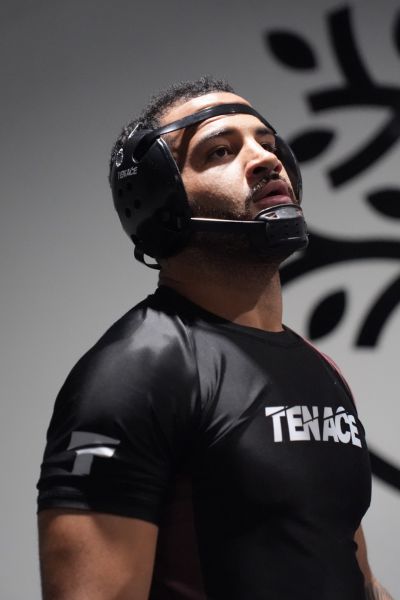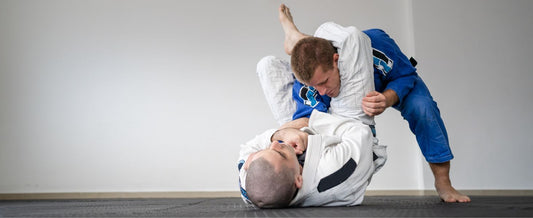- Why should sparring warm-up be specific?
- Extended stretching before combat and what alternatives to use.
- The risk of starting too strong
- The most injured joints… and how to activate them
- Warming up is also mental
There's no worse feeling than starting the first fight of the day without having properly prepared your body... and noticing that something isn't right.
Many people make the same mistakes before sparring. I did it too at first: warming up poorly, not warming up enough, or not warming up at all. But over time (and with the occasional ache or injury), I've learned that warming up isn't just another routine ; it's the first defense against injury and the first opportunity to improve your performance .
Here I share with you the 5 most common mistakes when warming up before sparring , and most importantly: how to correct them.
These blogs may also interest you:
- Why use earguards in martial arts? – Tenace
- Customizing Your earguards – Tenace
- Ultimate Guide to Choosing Protective Gear for Sparring: – Tenace
1. Warm up as if it were just another class
Many fighters warm up on autopilot. They do some gentle stretches, a couple of hip movements, and maybe a few laps on the mat. But they don't adapt their warm-up to the intensity of sparring . This is all about intensity, strength, speed, and reflexes. If you don't properly activate your muscles, joints, and mind, you can end up injured or simply not perform as well as you should.
Why is it not enough?
Because sparring radically activates your nervous system:
- Your heart rate goes up much faster.
- Your muscles should be ready to tense and relax instantly.
- Your mind needs to be alert, anticipate, decide quickly.
If you go in without being properly energized, the first few minutes can be chaotic. You'll be short of breath, won't react well, and on top of that, you're vulnerable to sprains or strains.
How to fix it?
This can be solved by designing a specific warm-up for sparring days,
- Active mobility for 5 minutes (neck, shoulders, hips, knees).
- Light cardiovascular activation (jumping, moving, shadow grappling).
- Soft technical drills : such as technical lifts, leg entries or guard movements.
It must fulfill three functions:
- Raise your body temperature.
- Activate your muscles and joints.
- Ignite your mind for combat.

Tenace earguards - Ear Protector
2. Stretch statically before combat
There are wrestlers who, before training, sit on the mat and do prolonged static stretches: splits, bridges, toe touches, etc.
What happens when you do this?
You relax your muscles, reducing the natural tension in your tissue… and that directly affects your ability to generate strength and speed.
But you need your muscles to be active, not numb. Pre-move tension is essential for reacting quickly, breaking a fall, defending a takedown, or accurately adjusting a hold.
What to do instead? Active and dynamic mobility.
- Leg swings.
- Circular joint mobility.
- Squats with arms extended.
- Gentle movements of the hip, back and neck.
This type of mobility maintains joint range without shutting down your power.
Leave deep stretching for after your workout or for a dedicated recovery session.
3. Start full throttle from the first second
The "sparring" sounds, and many enter as if they were in a final: brute force, high-speed transitions, rapid breathing...
The problem is that neither the body nor the cardiovascular system are fully prepared yet.
This mistake not only increases your risk of injury , it also causes you to tire prematurely, lose technique, and make poor decisions in combat.
What should you do?
Use your first sparring session as a "technical sparring" or warm-up. Choose a trusted partner and focus on fluidity, control, and breathing . Gradually increase the intensity. Ideally, use the first few rounds as an adjustment phase. Start at a medium pace, focusing on technical connection and precision. Breathe consciously, feel your partner's movement, and allow your body to warm up through the movement. Gradually, easing into the session will allow you to maintain quality for longer and will also help you learn more.
It's not about training softly, it's about training with your head .
4. Forgetting to prepare the areas that suffer the most: knees, elbows, neck
Over time, we all know which parts of the body take the brunt: knees, elbows, and neck. These joints receive the most pressure, whether from falls, constant weight bearing, or sudden force.
Still, many times no one activates them before sparring.
What can you do to take care of them?
- Knees : low movements, controlled squats, internal/external mobility.
- Elbows : wrist mobility, gentle flexion, controlled four-point support.
- Neck : gentle twists, light isometric work, postural control exercises.
Activating them before sparring isn't optional. Do deep squats and hip mobility to protect your knees, work on isometric pressure and mobility for your elbows, and perform controlled rotations and gentle activation exercises for your neck. This reduces friction, improves local circulation, and prevents repetitive injuries.
And if you're already experiencing discomfort, don't hesitate: use specific protection . It's not a sign of weakness; it's a smart way to train longer.



Tenace Protectors
5. Enter without mental focus
An energized body without a prepared mind doesn't perform as well . Warming up your mind is also part of the process.
You may be physically on the mat, but mentally still focused on work, your phone, or what you did the day before. This state of mental disconnection is more common than it seems, and it's one of the main reasons why many people train without real progress.
Sparring isn't just physical: it requires focus, tactical awareness, and quick decisions. If you don't train your mind to be present, you won't read the moves, react too late, and make mistakes that could have been avoided. Before rolling, take a few minutes to breathe, visualize what you want to work on, and focus on the moment.
- Do 2 minutes of deep breathing.
- Visualize what you want to work on that day (a guard, a pass, a defense).
- Take the time to mentally get into training mode.
Training with intention transforms any session.
Warm up like your performance depends on it (because it does)
Warming up isn't a formality. It's your main tool for preventing injuries, performing better, and enjoying sparring.
Incorporating mobility, progressive activation, and mental focus can make the difference between a good workout… and an injury that keeps you out for weeks.
Many people continue to train with constant discomfort. And the reality is that it can be avoided.
At Tenace , we design protections specifically designed for combat sports:
- Knee braces with stabilizers, perfect for preventing injuries or training safely if you're already experiencing discomfort.
- Comfortable, breathable elbow braces with reinforcement just where you need it most.
- Adjustable earguards so they don't ruin your session or leave marks that last a lifetime.
👉 Check out our collection at: tenacesports.com
Do you usually prepare your body well before sparring? Have you made any of these mistakes?
Leave us a comment and share your experience. We're building a community of fighters who care for each other, support each other, and evolve together. 💥👊





